Australian clinical therapists Vicki and James Childs are staunch advocates for underdogs. They are the proud parents of two adopted dogs, Freya and Rainey, and three ElderBulls that have crossed the rainbow bridge (see their tribute page on Instagram).
Vicki shares, “I have owned and loved rescue dogs since I was 20 years old. I first met a Staffordshire Bull Terrier when I was 14 years old, and my heart was won over from that moment on. I’ve never met a Staffy I haven’t liked. They are and will forever be my ‘heart breed.’”
With a vast experience of working with various rescue groups, Vicki has adopted seven dogs over the past 30 years, all of whom have lived long and wonderful lives. She opens up about her adoption experiences with her husband James, and their newest adventures with three-year-old Freya (a Staffordshire Bull Terrier) and 10-month-old Rainey (an American Staffordshire Terrier).
Help out by donating to Dog Rescue Newcastle
With your kind assistance, Dog Rescue Newcastle can rescue more abandoned, neglected, and abused companion animals in the Hunter Region.
Waldo’s Friends (WF): Can you tell us about the first pet you adopted with James?
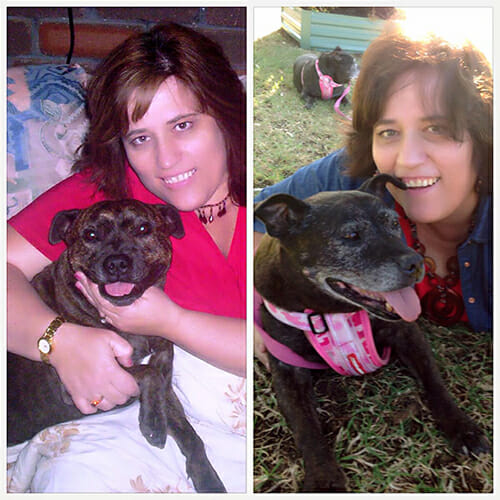
Vicki Childs (VC): James and I fell in love in 2002. Shortly after, we rescued and adopted our first girl together, Fat Flea. Fat Flea had a fantastic life story, from a horrible beginning which included being riddled with mange and worms to a life of fame.
In 2013, she was immortalised at Sydney’s iconic and world-renowned Bondi Beach as “Sydney’s Happiest Staffy.” It was such an incredible thing for a rescue girl to achieve. She was handpicked by the artist out of thousands of dog entrants to be painted in a mural at Bondi Beach. Called “Happy Staffies,” the mural showcased the loving nature of Staffordshire Bull Terriers. Flea had a remarkable life and was with us from 2003 until September 1, 2017, when she passed away at the grand age of 15.
WF: How did you come to adopt Freya?
VC: Freya came into our lives through Dog Rescue Newcastle. It was around six months after Fat Flea passed away. While we still had our other Elderbulls (Lilly Bet and Jack Dewy), we had a sense that due to their advanced age, we would more than likely lose one of them in the not-too-distant future.
While I was not actively looking, I have always wanted a Pied Staffordshire Bull Terrier. One night while scrolling through Facebook, this sassy little squat ball of muscle with the most charming face popped up on my feed. I stopped scrolling to admire her and was shocked that she was looking for a home. She was 16 months old and had already been in three homes, which is nothing unusual for some rescue dogs. But it was unfortunate to think that she had been in so many homes at less than two years old.
I screamed out to James to come and look at what I had found. He also thought she was lovely, but held little hope we would get her as she was a “true to type” Staffy, well-bred, incredibly appealing, and a Pied. Nonetheless, I lodged an application and hoped for the best. I was disheartened when I saw many people commenting and stating they were going to fill out applications. With two senior Elderbulls already in residence, I tried not to get my hopes up, but secretly, I was quietly manifesting this to happen.
Several days later, I received a call from Freya’s foster parents (who lived around 30 minutes away), asking if we would like to come and meet her. I almost jumped out of my skin and did a happy dance like I was 20 again.
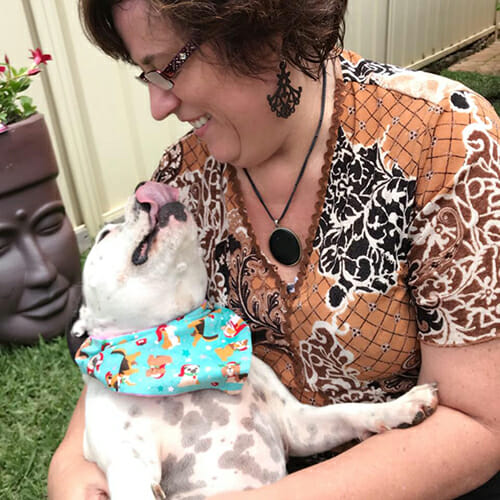
Upon seeing Freya in the flesh, I was taken aback at just how beautiful she was. But more than that, her temperament was as close to perfect as I’d seen. Freya was laid-back and happy, she demonstrated excellent body language when meeting Jack Dewy and Lilly Bet. We took them on a longish walk together, which always gives you a good reading for how the pack will order or reorder itself.
I knew from the first 20 seconds that Freya would be coming home to live with us. We had to wait 10 days before we could pick her up. It was the longest 10 days of our lives. We picked her up, brought her to a nearby park, and then reintroduced her to the Elderbulls. After that, we all walked home happily together.
WF: What about Rainey?
VC: Little Miss Rainey came to us in April 2019. We adopted her as Dewy had been diagnosed with terminal cancer. We did not want Freya to be on her own suddenly, and for the first time in over 15 years, we found ourselves looking for a puppy. Little did we know we would wind up with this energetic and smart Freya lookalike. At the time of her adoption, she was just shy of three months and already suffering the common ailments seen by pups who have been bred by backyard breeders: full of worms, mangey, pot-bellied, and extremely lethargic. But since coming home to live with us, she has returned to excellent health. She is doing well with her training and learning how to dog under the guidance of Freya and Dewy (before he passed in May 2019).
Our decision to adopt Freya and Rainey has been based on firsthand knowledge that these lovable souls are so deserving. These dogs absolutely know that they are given a second chance, and they pay you back in the most incredible way with a lifetime of love and loyalty. It feels good at a heart level to know you’ve taken an action which saves a soul. At the time, it may be only one soul, but that soul knows it has been afforded a new life. All of those saves combine to make a huge difference worldwide, and the movement now known as “adopt don’t shop” is considered an exceptional badge of honour among those who elect to adopt rather than shop.
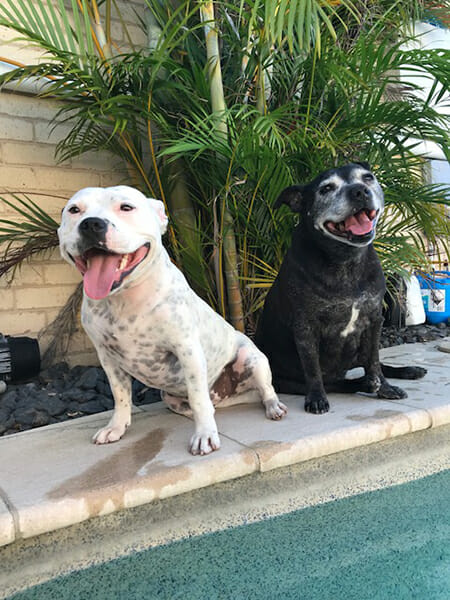
WF: As a mom of two Bull Breed canines, what would you say are their best traits? How would you convince others to adopt abandoned dogs belonging to this breed?
VC: Bull Breeds are very misunderstood. Unfortunately, the media has often incorrectly identified any type of dog with a “broad box-type head and muscly low-slung body” as a Bull Breed when often, that is not the case. Having owned nine Bull Breeds in my lifetime, I can emphatically impart that like any other breed, they are only what you instil into them. If you treat a Bull Breed with love and respect, that is precisely what you will get in return. They are beyond loyal and attach with great affection to their “family.”
Bull Breeds are ideal for families that want low-maintenance dogs. Their short coats are easily cared for, and they have excellent robust health. They love adults and children alike. If you’re searching for a best friend with a huge heart, then you need to consider a Bull Breed.
WF: What would you say are Freya and Rainey’s most fascinating quirks?
VC: These two girls love watching children on TV. Freya will often go right up to the TV and try to lick a child on the screen if she sees them crying. It’s very endearing and speaks volumes of this breed’s love of and for children.
Freya loves the camera. As soon as she hears my lens cap come off my camera or sees my phone move up to her height, she starts posing. She barks and tries to engage with the camera, offering up that unique and irresistible smile. On occasion, she will even wink on command for a photo.
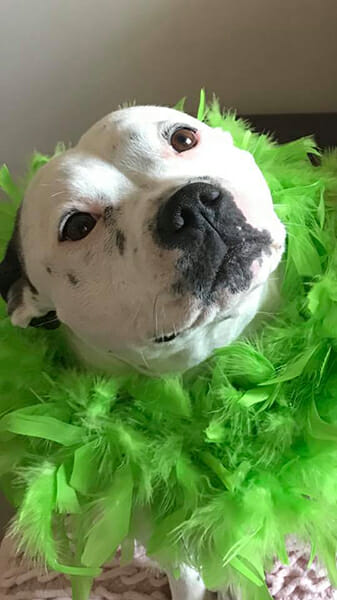
Rainey is somewhat of an athlete; she is very fit and extremely agile. Rainey loves nothing more than playfully teasing Freya. It’s never out of the ordinary to see Rainey on top of her three-feet-high kennel, hiding all of their toys and bones so Freya can’t reach them. Rainey delights in being taller and more agile than sweet Freya. Often she gets this little smirk on her face, which is quite hilarious. Rainey is the most curious of all our rescue dogs to date.
WF: What are the things Freya and Rainey enjoy doing with you?
VC: They are “people” dogs and thrive on being part of the family. They are gloriously happy keeping us company while we relax around the home and equally happy accompanying us on outings just about anywhere.
Our dogs act as roving educational ambassadors for all Bull Breeds everywhere; we often take them to pet events and fairs where they demonstrate just how well-behaved and lovable they can be. Freya and Rainey love going out to meet people. They have a better social life than many people we know. As an aside to that, we all love going bush out into nature where the girls can run and experience total freedom in wide open, isolated spaces.
WF: An Instagram post reveals that Freya is training to be a therapy dog. Could you talk more about this journey with her?
VC: Freya is training to be a Delta Dog. With our line of work, many clients present extreme anxiety and restlessness. A gentle and kind dog laying at your feet or sitting next to you can make all the difference and bring anxiety levels down.
Freya’s training had been going well, but disaster struck with Freya requiring surgery on one of her knees. We will be resuming training after she has fully recovered. Training to be a therapy dog doesn’t mean the dog needs to be perfect. It means the dog needs excellent manners and understands what is acceptable and not acceptable in terms of supporting a person. The dog needs to have an affable nature and love people; these are all traits of Bull Breeds. We are also hoping to train Rainey once she turns one.
WF: Your other Instagram account focuses on elderly Bull Breeds. What would you say is the best thing about having senior pets at home?
VC: Senior dogs bring something extra special. There is a wisdom and dignity in older dogs that belies any real description. It’s a knowingness, an almost calming energy that greets all who are lucky enough to engage with a senior dog. They know the drill, so to speak. They have lived a life of keen observation, and with that often comes intuitive knowledge of how their respective owners are feeling and what they need without having to speak the words.
Of course, the other fantastic aspect of seniors is all of the memories they bring every time you gaze upon their perfect sugar-frosted faces. Adopting an aged pet is ideal for those who don’t want to wait out the puppy phase of chewing, barking, and learning how to dog. Seniors already know how to dog with great skill.
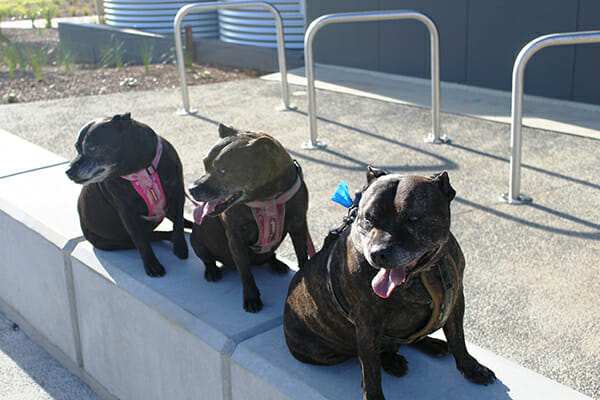
WF: What’s your advice for people adopting senior dogs for the first time? On a related note, what considerations should they take note of in caring for these pets?
VC: The prime thing to remember is that a senior dog has already lived a life and it may not be in accordance with the life you are now expecting of them. Take some time to allow them to observe how you do things and how your household runs, and what expectations you have of them. Like all things in life, it takes a few weeks for you to become comfortable with one another; to learn each other’s likes, dislikes, and quirks. It’s also important to remember that senior dogs won’t need the same amount of exercise that a pup may. Many seniors are happy to bask in the sun with a short walk in the afternoon.
In terms of caring for a senior dog, it’s important that they have a nice comfortable bed as they can get a little less mobile as they reach their twilight years. A proper diet with plenty of fresh, meaty bones goes a long way to longevity and amuses any age. Plenty of fresh water, short walks, trips, and inclusion in your life as much as possible all help a dog live a long and happy life.
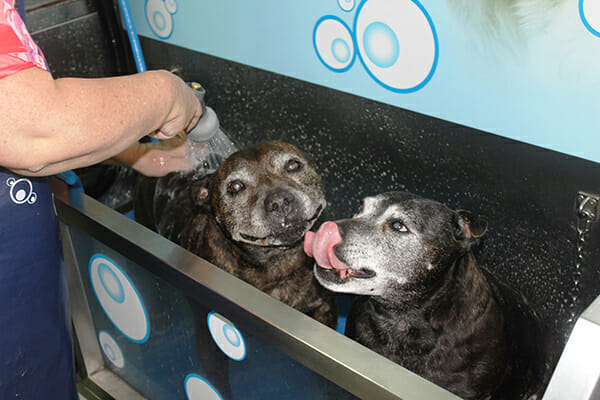
WF: What’s the best tip you can give for first-time animal owners?
VC: Be patient and kind with your pet. Often, it can take a while for the pet to understand what you are asking of it. Be generous with your praise and cautious with your criticism. Remember that your pet isn’t a toy or an ornament. Pets thrive when they are included in family life, cared for, and nurtured as part of a family. Enjoy the journey, and where possible, strive to grow together.
Also, set consistent rules and don’t expect that your new pet will automatically know it is not allowed to jump on the couch or dig holes. These are behaviours which you need to train your pet to understand.
WF: What’s your advice for people thinking of adopting a rescue animal?
VC: There are a few primary considerations to take into account when adopting a rescue animal. The very first thing to do is spend quality time with the animal you are thinking of adopting. Just like people, animals have very distinct personalities, and some animals get along better with one person or another animal than they do another.
Our key advice is to understand that the dog you view straight out of the pound or kennel may not be the dog you see after the settling in period. Often, animals will shut down or give up after extended periods of being locked in a small concrete cell. They can appear to be lifeless, depressed, or even naughty. (Let’s face it. Who wouldn’t be feeling like this in the same circumstance?) After spending an hour or so out of the kennel, the animal’s real personality may start to show. Sometimes, a very quiet and shy dog will transform into a loving, outgoing, and energetic ball of fun just knowing it has its freedom outside of that kennel for only an hour or so. This is why it’s important to spend as much time observing the pet’s behaviour in the time you have. If that means visiting several times over the course of a week, then take the time to ensure you’re getting a good fit.
The other thing to remember is that it’s going to take some time for adopted animals to feel comfortable in their new surroundings. When they first go home with you, they will want to explore and search around the house and yard; they may even run around doing zoomies and bark with joy at being free. Allow the newly rescued pet to do this. Equate this to moving into a new home yourself. It takes time to make a new home feel comfortable and be at ease with your new surroundings. Forgive any little “accidents” quickly; these new family members don’t know your rules yet.
Also, factor in the breed of the dog. If you’re a very active person who enjoys jogging, you’d be best to get a high-energy dog. If you’re a “Netflix and chill” kind of person, a happy lounge lizard with a “fat boy” attitude will be a perfect fit. Rescue dogs are not second-class citizens. Most of the time, they are victims of circumstances. They are full of life and love, just waiting for an opportunity to shine.
WF: How has your life changed after adopting your pets?
VC: Our lives have been significantly better since we started the process of adopting our pets. We are happier, healthier, and now have a much wider circle of friends. With social media being a wonderful way to share our pets, we have met some of the most amazing friends all over the world, many of whom are adoptive parents too!
Having a friend who loves you unconditionally is a beautiful feeling, and these adopted pets show so much gratitude and love for their new lives.
WF: Why would you personally encourage adopting animals?
VC: There are so many reasons to adopt an animal. When you decide to adopt a pet, you are making a conscious effort to save a life, and that’s an honourable and kind thing to do. The world is short on kindness, and your one gesture has a ripple effect in that your friends, family, and even work colleagues get to witness how an adopted animal can positively impact a person or family.
Adopting an animal often assists in breaking the cycle of unscrupulous backyard breeding. Why pay thousands of dollars for an often genetically unsound pet when you can see exactly what you are getting (looks and temperament wise) when adopting?
For Jim and I and many other friends, adopting an animal feels good. It allows you to understand that these animals are not broken or defective, they just need a second chance. Opening your heart to an adopted animal is one of the most beautiful things you can do, and we promise you that in time, you will feel like you were the one who may have been rescued.
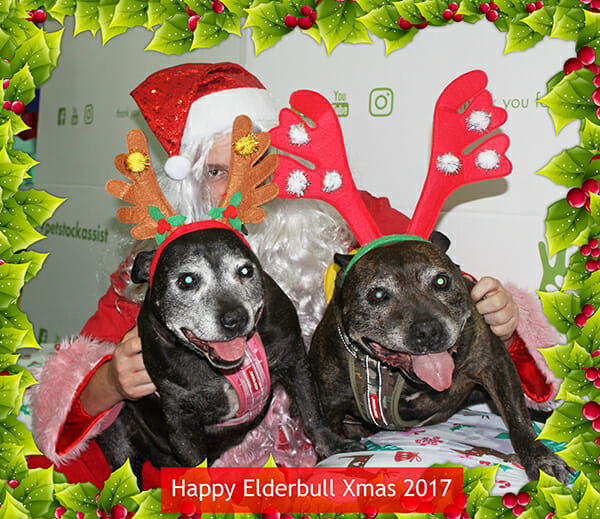
even as far as Norway and Brazil
Follow the adventures of Freya and Rainey on Instagram.
Read more rescue stories here! Do you know of an interesting pet adoption, foster, or rescue story? Share your suggestion with us by commenting below!
Leave a comment
Your email address will not be published. All fields are required.